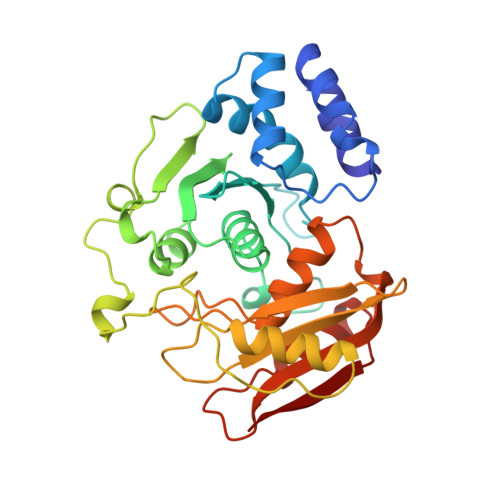The structure of the cytidine deaminase-product complex provides evidence for efficient proton transfer and ground-state destabilization.
Xiang, S., Short, S.A., Wolfenden, R., Carter Jr., C.W.(1997) Biochemistry 36: 4768-4774
- PubMed: 9125497
- DOI: https://doi.org/10.1021/bi963091e
- Primary Citation of Related Structures:
1AF2 - PubMed Abstract:
Crystal structures of the cytidine deaminase-uridine product complex prepared either by cocrystallizing enzyme with uridine or by diffusing cytidine into ligand-free crystals show that the product binds as a 4-ketopyrimidine. They reveal four additional features of the catalytic process. (1) A water molecule bound to a site previously observed to bind the incoming 4-NH2 group represents the site for the leaving ammonia molecule. The conserved Pro 128 accommodates both moieties by orienting the carbonyl group of the previous residue. (2) The Glu 104 carboxylate group rotates from its hydrogen bond to the O4 hydroxyl group in transition-state analog complexes, forming a new hydrogen bond to the leaving group moiety. Thus, after stabilizing the hydroxyl group in the transition state, Glu 104 transfers a proton from that group to the leaving amino group, promoting enol-to-keto isomerization of the product. (3) Difference Fourier comparisons with transition-state complexes indicate that the pyrimidine ring rotates toward the zinc by approximately 10 degrees. The active site thus "pulls" the ring and 4-NH2 group in opposite directions during catalysis. To preserve coplanarity of the 4-keto group with the pyrimidine ring, the N1-C1' glycosidic bond bends by approximately 19 degrees out of the ring plane. This distortion may "spring-load" the product complex and promote dissociation. Failure to recognize a similar distortion could explain an earlier crystallographic interpretation of the adenosine deaminase-inosine complex [Wilson, D. K., & Quiocho, F. A. (1994) Nat. Struct. Biol. 1, 691-694]. (4) The Zn-Sgamma132 bond, which lengthens in transition-state complexes, shortens as the O4 atom returns to a state of lower negative charge in the planar product, consistent with our previous proposal that this bond buffers the zinc bond valence, compensating buildup of negative charge on the oxygen nucleophile during catalysis.
- Department of Biochemistry and Biophysics, University of North Carolina at Chapel Hill, 27599-7260, USA.
Organizational Affiliation:


















